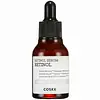What's inside
What's inside
 Key Ingredients
Key Ingredients

 Benefits
Benefits

 Concerns
Concerns

 Ingredients Side-by-side
Ingredients Side-by-side

Calendula Officinalis Extract
Skin ConditioningButylene Glycol
HumectantGlycerin
HumectantHelianthus Annuus Seed Oil
Emollient1,2-Hexanediol
Skin ConditioningPolysorbate 60
EmulsifyingBetaine
HumectantDimethicone
EmollientCetearyl Alcohol
EmollientRetinyl Palmitate
Skin ConditioningCetearyl Olivate
Panthenol
Skin ConditioningArachis Hypogaea Oil
Skin ConditioningSorbitan Olivate
EmulsifyingAllantoin
Skin ConditioningTocopheryl Acetate
AntioxidantHydroxyethyl Acrylate/Sodium Acryloyldimethyl Taurate Copolymer
Emulsion StabilisingHydroxyethylcellulose
Emulsion StabilisingXanthan Gum
EmulsifyingJuniperus Mexicana Oil
MaskingEthylhexylglycerin
Skin ConditioningAdenosine
Skin ConditioningTocopherol
AntioxidantCalendula Officinalis Extract, Butylene Glycol, Glycerin, Helianthus Annuus Seed Oil, 1,2-Hexanediol, Polysorbate 60, Betaine, Dimethicone, Cetearyl Alcohol, Retinyl Palmitate, Cetearyl Olivate, Panthenol, Arachis Hypogaea Oil, Sorbitan Olivate, Allantoin, Tocopheryl Acetate, Hydroxyethyl Acrylate/Sodium Acryloyldimethyl Taurate Copolymer, Hydroxyethylcellulose, Xanthan Gum, Juniperus Mexicana Oil, Ethylhexylglycerin, Adenosine, Tocopherol
Water
Skin ConditioningIsododecane
EmollientCyclopentasiloxane
EmollientNiacinamide
SmoothingPropanediol
SolventDimethicone
EmollientPEG-12 Glyceryl Dimyristate
Skin ConditioningGlycerin
HumectantTapioca Starch Polymethylsilsesquioxane
AbsorbentCetearyl Alcohol
EmollientHydroxyphenoxy Propionic Acid
Skin ConditioningPentylene Glycol
Skin ConditioningPolysilicone-11
Glyceryl Stearate
EmollientPEG-100 Stearate
Hexylresorcinol
AntimicrobialCoco-Caprylate/Caprate
EmollientResveratrol
AntioxidantPhenoxyethanol
PreservativeRetinol
Skin ConditioningPolysorbate 20
EmulsifyingButylene Glycol
HumectantSodium Polyacrylate
AbsorbentCaprylyl Glycol
EmollientEthylhexyl Stearate
EmollientAmmonium Acryloyldimethyltaurate/Vp Copolymer
Xanthan Gum
EmulsifyingChlorphenesin
AntimicrobialSodium Citrate
BufferingTocopheryl Acetate
AntioxidantTrideceth-6
EmulsifyingDisodium EDTA
Decyl Glucoside
CleansingAminomethyl Propanol
BufferingWater, Isododecane, Cyclopentasiloxane, Niacinamide, Propanediol, Dimethicone, PEG-12 Glyceryl Dimyristate, Glycerin, Tapioca Starch Polymethylsilsesquioxane, Cetearyl Alcohol, Hydroxyphenoxy Propionic Acid, Pentylene Glycol, Polysilicone-11, Glyceryl Stearate, PEG-100 Stearate, Hexylresorcinol, Coco-Caprylate/Caprate, Resveratrol, Phenoxyethanol, Retinol, Polysorbate 20, Butylene Glycol, Sodium Polyacrylate, Caprylyl Glycol, Ethylhexyl Stearate, Ammonium Acryloyldimethyltaurate/Vp Copolymer, Xanthan Gum, Chlorphenesin, Sodium Citrate, Tocopheryl Acetate, Trideceth-6, Disodium EDTA, Decyl Glucoside, Aminomethyl Propanol
Ingredients Explained
These ingredients are found in both products.
Ingredients higher up in an ingredient list are typically present in a larger amount.
Butylene Glycol (or BG) is used within cosmetic products for a few different reasons:
Overall, Butylene Glycol is a safe and well-rounded ingredient that works well with other ingredients.
Though this ingredient works well with most skin types, some people with sensitive skin may experience a reaction such as allergic rashes, closed comedones, or itchiness.
Learn more about Butylene GlycolCetearyl alcohol is a mixture of two fatty alcohols: cetyl alcohol and stearyl alcohol. It is mainly used as an emulsifier. Emulsifiers help prevent the separation of oils and products. Due to its composition, it can also be used to thicken a product or help create foam.
Cetearyl alcohol is an emollient. Emollients help soothe and hydrate the skin by trapping moisture.
Studies show Cetearyl alcohol is non-toxic and non-irritating. The FDA allows products labeled "alcohol-free" to have fatty alcohols.
This ingredient is usually derived from plant oils such as palm, vegetable, or coconut oils. There is debate on whether this ingredient will cause acne.
Due to the fatty acid base, this ingredient may not be Malassezia folliculitis safe.
Learn more about Cetearyl AlcoholDimethicone is a type of synthetic silicone created from natural materials such as quartz.
What it does:
Dimethicone comes in different viscosities:
Depending on the viscosity, dimethicone has different properties.
Ingredients lists don't always show which type is used, so we recommend reaching out to the brand if you have questions about the viscosity.
This ingredient is unlikely to cause irritation because it does not get absorbed into skin. However, people with silicone allergies should be careful about using this ingredient.
Note: Dimethicone may contribute to pilling. This is because it is not oil or water soluble, so pilling may occur when layered with products. When mixed with heavy oils in a formula, the outcome is also quite greasy.
Learn more about DimethiconeGlycerin is already naturally found in your skin. It helps moisturize and protect your skin.
A study from 2016 found glycerin to be more effective as a humectant than AHAs and hyaluronic acid.
As a humectant, it helps the skin stay hydrated by pulling moisture to your skin. The low molecular weight of glycerin allows it to pull moisture into the deeper layers of your skin.
Hydrated skin improves your skin barrier; Your skin barrier helps protect against irritants and bacteria.
Glycerin has also been found to have antimicrobial and antiviral properties. Due to these properties, glycerin is often used in wound and burn treatments.
In cosmetics, glycerin is usually derived from plants such as soybean or palm. However, it can also be sourced from animals, such as tallow or animal fat.
This ingredient is organic, colorless, odorless, and non-toxic.
Glycerin is the name for this ingredient in American English. British English uses Glycerol/Glycerine.
Learn more about GlycerinTocopheryl Acetate is AKA Vitamin E. It is an antioxidant and protects your skin from free radicals. Free radicals damage the skin by breaking down collagen.
One study found using Tocopheryl Acetate with Vitamin C decreased the number of sunburned cells.
Tocopheryl Acetate is commonly found in both skincare and dietary supplements.
Learn more about Tocopheryl AcetateXanthan gum is used as a stabilizer and thickener within cosmetic products. It helps give products a sticky, thick feeling - preventing them from being too runny.
On the technical side of things, xanthan gum is a polysaccharide - a combination consisting of multiple sugar molecules bonded together.
Xanthan gum is a pretty common and great ingredient. It is a natural, non-toxic, non-irritating ingredient that is also commonly used in food products.
Learn more about Xanthan Gum